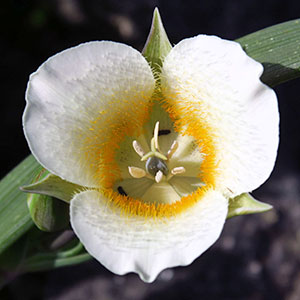Calochortus subalpinus
Calochortus clavatus
Cascade mariposa lily, cat's ear lily, mountain cat's ear, mountain mariposa, subalpine mariposa-lily
club hair mariposa, clubhair mariposa lily, slender mariposa lily
usually not branching, straight or flexuous, often scapelike, 0.5–3 dm.
slender or coarse, stout, branching or not, strongly flexuous, 3–10 dm.
basal 1–3 dm × 2–15 mm, usually equaling or exceeding stem length;
blade flat, adaxial surface glabrous.
basal withering, 1–2 dm;
blade linear.
subumbellate, 1–5-flowered;
bracts 2–several, lanceolate to linear, unequal, 1–5 cm, apex acuminate;
peduncle slender, becoming stouter, deflexed in fruit.
subumbellate, 1–6-flowered;
bracts 4–8 cm, bases dilated.
erect or spreading;
perianth open, campanulate;
sepals typically with purple glandular blotch near base, oblong-lanceolate, shorter than petals, adaxial surface minutely hairy, apex acute to acuminate;
petals yellowish white, sometimes lavender-tinged, frequently with narrow purple crescent distal to gland, broadly obovate, cuneate, moderately bearded nearly to apex, adaxial surface densely hairy, margins fringed, apex obtuse or acute;
glands transversely oblong, arched upward, ± deeply depressed, bordered proximally by narrow, ascending, deeply fringed membrane, distally by narrow, crenate membranes, gland surface with rather long, slender hairs toward distal portion;
anthers lanceolate, apex long-apiculate.
erect;
perianth open, cup-shaped;
sepals usually with red-brown blotch at base, lanceolate-ovate, 2–4 cm, apex acute;
petals lemon to golden yellow, with transverse line distal to gland, broadly cuneate to obovate, 3–5 cm;
glands round, deeply depressed, densely covered with short hairs with branching, coralline tips, surrounded by conspicuously fringed membrane and club-shaped hairs;
filaments ca. 10 mm;
anthers purplish brown, oblong, 4–10 mm.
nodding, 3-winged, ellipsoid, apex usually acute.
erect, lanceoloid-linear, angled, 6–9 cm, apex acuminate.
pale yellow.
light yellow, translucent, flat.
= 20.
= 16.
Calochortus subalpinus
Calochortus clavatus
Varieties 5 (5 in the flora).
(Discussion copyrighted by Flora of North America; reprinted with permission.)
1. Petals shorter than sepals; petal glands very deeply depressed. | var. avius |
1. Petals longer than sepals; petal glands shallowly to moderately depressed. | → 2 |
2. Stems straight, slender, usually 3 dm or shorter. | → 2 |
2. Stems flexuous, coarse, usually 5–10 dm. | → 3 |
3. Petals 3–4 cm, sparsely bearded; leaves not recurved. | var. gracilis |
3. Petals 4–5 cm, bearded; leaves strongly recurved. | var. recurvifolius |
4. Petals deep yellow, hairs very knobby; anthers deep purple. | var. clavatus |
4. Petals light yellow, hairs not very knobby; anthers yellow to medium purple. | var. pallidus |
